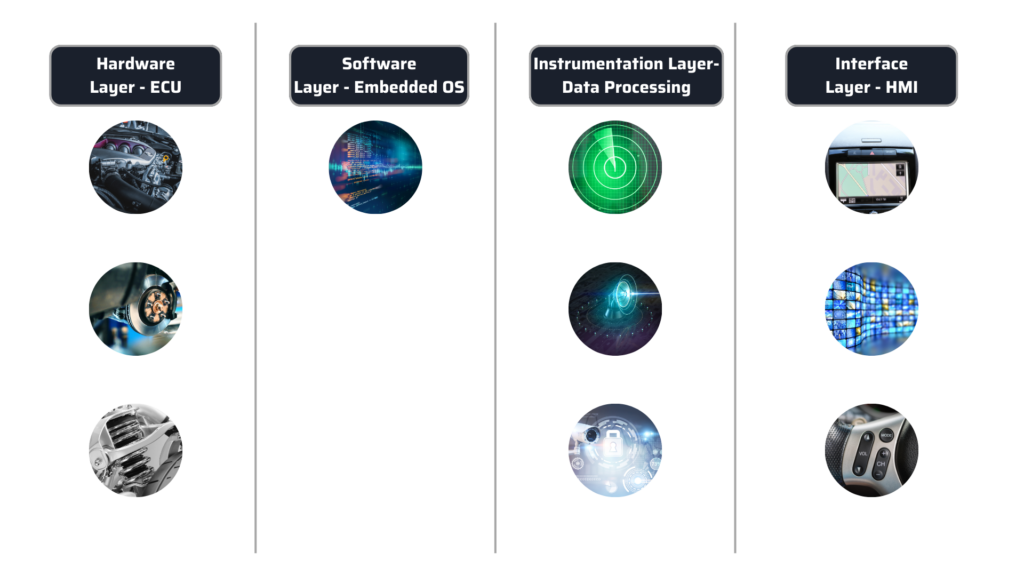Understanding Software-Defined Vehicles
The quick progress in in-car technology has introduced a new period where software is key in how vehicles operate. SDVs offer a major change from conventional vehicle design, which was mainly based on mechanical and hardware systems, to a new era driven by software innovation. This shift signifies a crucial point in the automotive sector, with embedded systems playing a central role in this advancement. Historically, conventional vehicles have mainly been operated by hardware, depending on mechanical components and embedded systems with restricted capabilities. Every individual electronic control unit (ECU) controlled a specific subsystem, such as braking or infotainment, resulting in a divided and less flexible system structure.
The tech giants are now seeing growth in the adoption of SDVs globally. The global market size of the SDV is projected to grow from USD 213.5 billion in 2024 to USD 1,237.6 billion by 2030, with a Compound Annual Growth Rate (CAGR) of 34%, as reported by MarketsAndMarkets.
The role of embedded systems in SDVs
Embedded systems play a vital role in ensuring seamless integration of hardware and software in SDVs. Embedded systems carry out some essential functions, but the vehicles are getting more complicated, with multiple hardware and software in play. The wide range of sensors, information screens, and functions, are ideally integrated into a common software platform. An SDV platform should enable the car’s onboard systems to share information easily between themselves and with secure resources in the cloud. Considering the example of a next-generation electric vehicle. The car battery’s state of charging informs routing decisions in its navigation systems, suggesting appropriate charging stops. The navigational information is displayed on drivers’ infotainment screens or projected onto the windscreen via Heads-up-display (HUD).
One more significant role that embedded systems play in dynamic driving settings is the power and suspension deployed automatically to real-time information supplied by the navigation systems and sensor arrays, along with the latest road and weather conditions via wireless connection to the cloud. Along with continuously downloading data, SDVs can also upload telematics and diagnostics to be analyzed to teach the car how to predict and respond to the driver’s needs. Vehicle owner can access this information and more using an app on their phone. This connectivity can enable remote control of car systems.
The SDV is designed to deliver enhanced optimization, advanced features, and expanded capabilities wirelessly through its architecture. The SDV relies on a 4-layer architecture to ensure seamless integration and superior performance.

Architecture of SDVs
- Hardware Layer: In the hardware layer, ECUs play an important role in controlling the vehicle’s critical components, such as the powertrain, braking, and suspension. They are responsible for executing real-time control algorithms, processing sensor data, and driving actuators, ensuring real-time response and safety. The ECUs interact with upper layers by exchanging data across in-vehicle networks.
- Software Layer: In the software layer, embedded systems oversee controlling and managing hardware resources. The Real-Time Operating System (RTOS) ensures that software applications running on ECUs or processors are prioritized correctly and executed without any delay. Also, the embedded operating system enables smooth communication between software and hardware, allowing efficient interaction and integration between the two components.
- Instrumentation Layer: The embedded systems in the instrumentation layer handle sensor fusion and data processing from the vehicle’s external environment (e.g., through radar, LiDAR, and cameras). The AI-driven algorithms process the fused sensor data to deliver real-time safety responses. Embedded systems in this layer manage computationally intensive operations such as image recognition and use high-speed in-vehicle networks to communicate with the hardware and software layers, enabling actions like automatic braking or steering adjustments.
- Interface Layer: At the interface layer, embedded systems control the Human-Machine Interface, bridging the vehicle’s internal systems with user inputs. This layer integrates infotainment systems, digital displays, and traditional control mechanisms (like buttons or steering wheel controls). Real-time communication protocols are crucial here, as embedded systems ensure that driver commands are instantly relayed to the underlying systems and that feedback (visual, auditory, or tactile) is provided to the driver in real-time. The interface layer also includes embedded processors for tasks like voice recognition and digital cockpit display rendering, communicating back through the same network channels as the hardware, software, and instrumentation layers to ensure the vehicle reacts smoothly to user inputs.
Advantages of SDV with embedded systems
- ADAS: By combining sensors, actuators, Artificial Intelligence and Machine Learning algorithms, and computer vision, self-driving vehicles offer functions like lane-keeping assist, adaptive cruise control, and automatic emergency braking. Embedded development and RTOS implementation guarantee that these systems react promptly and correctly to varying environmental circumstances.
- V2X Communication: V2X Communication enables vehicles to communicate with infrastructure and other vehicles, resulting in safer roads and reduced traffic congestion. Embedded systems are responsible for handling the necessary real-time data transfer for V2X, enhancing the vehicle’s ability to make rapid decisions.
- OTA Updates: One of the benefits of SDVs is their ability to receive updates wirelessly, which means they can be improved in terms of performance, features, and security without needing any hands-on intervention. This leads to time and cost savings, as well as enhancing the durability and versatility of the vehicle. Customization can also be achieved with software updates, giving users the ability to tailor their driving experiences by adjusting performance and infotainment settings.
The Future of SDVs
The automotive industry is expected to be significantly impacted by the emergence of SDVs. SDVs will redefine the future of transportation, from changing ownership models to impacting supply chains. The use of SDVs allows for the use of cutting-edge computer vision, sensor fusion, and decision-making algorithms, which help to overcome obstacles in integrating autonomous driving technologies.
In conclusion, the prevalent system has shown to be insufficient as consumer demands for improved connectivity, personalization, and automation. The SDVs offer transformative solutions by providing a unified platform that enables rapid data processing and seamless OTA updates to vehicle functions through software, without any hardware changes. Ultimately SDV benefits both manufacturers and consumers by allowing faster innovation and more responsive and advanced vehicle systems.
With years of experience in automotive audio, video, connectivity solutions (including CAN, wireless mesh, and Wi-Fi), edge platforms, and advanced sensor integration, MosChip empowers automotive businesses to integrate cutting-edge cognitive features, seamless infotainment systems, and autonomous driving technologies. From smart parking, object/lane detection, driver distraction to engine health diagnostics, our solutions are designed to future-proof vehicles, making them ready for the rapidly evolving demands of the automotive market.
Author
-
Ambuj is a Marketing professional at MosChip creating impactful techno-commercial writeups and conducting extensive market research to promote businesses on various platforms. He has been a passionate marketer for more than three years and is constantly looking for new endeavours to take on. When He’s not working, Ambuj can be found riding his bike or exploring new destinations.






